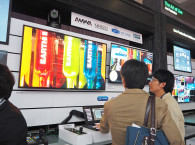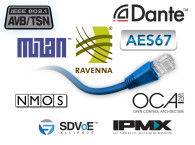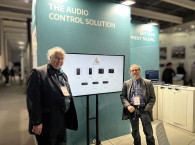As I said in my First Impressions article, at ISE 2019 the dominant audio networking technology was without a doubt Audinate's Dante, even if in a few other manufacturers' booths there was mention of Ravenna and AES67 and, of course, QSC was "talking" Q-LAN/AES67.
In this domain, ISE 2019 was once again flooded with literally thousands of Dante-enabled products being presented by hundreds of companies. And Audinate announced its new Dante AV solution, an integrated audio and video-over-IP approach with which manufacturers will be able to add networked video to a Dante audio-over-IP platform. This is a solution that Audinate will be developing further, including in cooperation with the SDVoE Alliance, as announced in 2018.
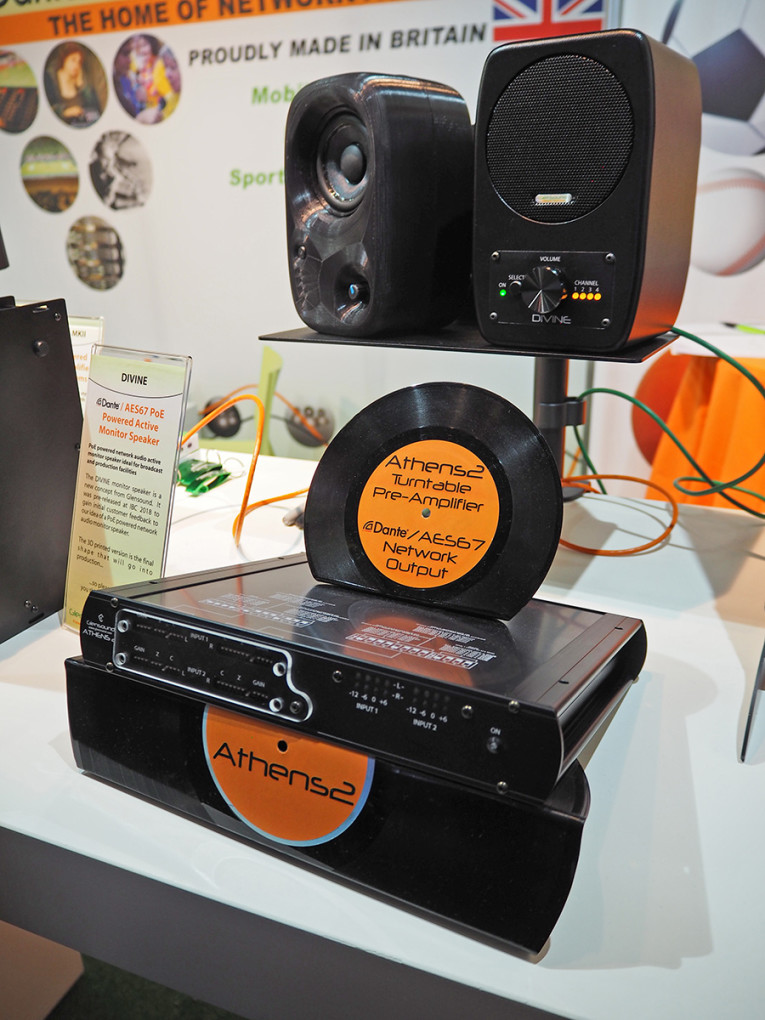
The SDVoE Alliance is an industry consortium driving standardization of "no-compromise AV signal transport over Ethernet," to create an integrated AV control environment for AV distribution and processing applications that demand zero-latency. Audinate has joined the SDVoE Alliance as a contributing member since this would enable an integrated, interoperable way to control video over IP alongside Dante audio, focusing more on commercial installation, digital signage, and conferencing. Now, Dante AV promises to be interoperable with the SDVoE efforts, even if both the SDVoE Alliance and Audinate will also eventually have to embrace interoperability with the SMPTE ST-2110 suite of standards.
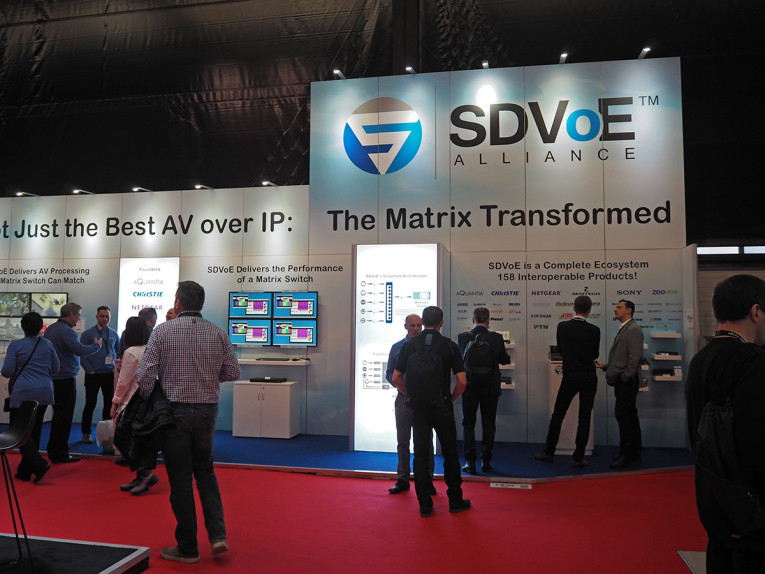

At NAB 2018, Audinate announced plans to support SMPTE ST-2110 in the Dante platform "by the end of 2018." Well, that specific firmware update is not available yet, and with the introduction of Dante AV, it's easy to understand where Audinate has been focused. Dante was always promoted as a "media networking technology" and that meant also supporting video. Now that Audinate has developed Dante AV - which is supposed to be video codec agnostic, but already adopted the IntoPIX JPEG2000 codec as part of the Dante AV Product Design Suite available for manufacturers - it would be a logic progression. While the ST-2110 specifications currently define uncompressed video, there is an extension being developed for compressed video (2110-22: Compressed Video Essence) explaining how to transport J2K/TICO/AVCI/JPEG-XS coded material.
During ISE 2019, I also attended The Alliance for IP Media Solutions (AIMS) conference, where Andreas Hildebrand (ALC NetworX) discussed ST2110 in detail and mentioned the compressed video extension under development. More details are expected in 2019, but this will certainly be a key development for AV applications. The IntoPix website offers a nice overview of the work in progress here.
But I mentioned briefly QSC, and the fact that the Costa Mesa, CA, company was promoting its new Q-Sys Ecosystem now featuring native video streaming as well as audio and control was another ISE 2019 highlight. QSC also promoted its new Q-SYS Reflect Enterprise Manager software, designed to provide monitoring and management capabilities for all native Q-SYS devices and third-party peripherals within a Q-SYS system. As audioXpress reported prior to the show, QSC and Audinate also announced a partnership to "develop cross-platform technology that will promote truly unique integrations between QSC solutions and Audinate licensed products." The first round of co-developed solutions are scheduled for availability later in 2019. In the announcement, QSC says the company is "committed to bridging the gap between disparate AV systems, peripherals, and protocols by providing an agnostic, open-standard approach to audio, video, and control."
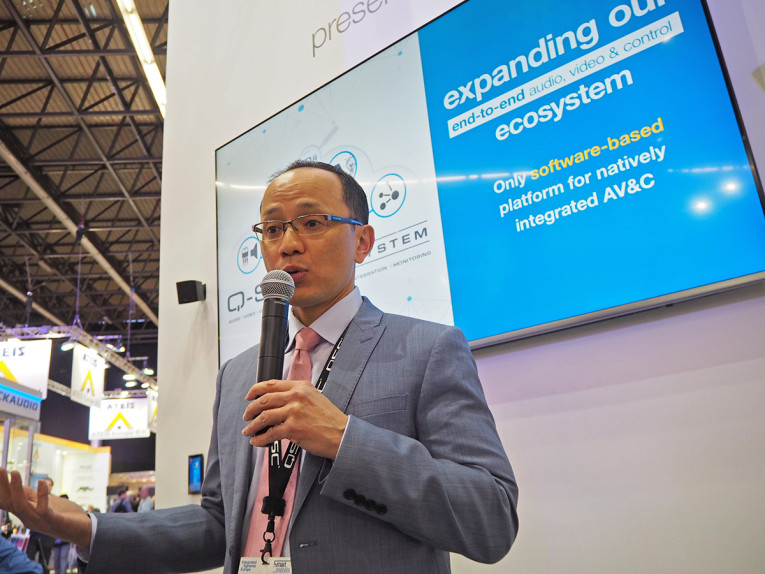
I tried my best to ask questions to Audinate about what this partnership announcement with QSC will mean, but I received only smiles. Well, Dante-based and QSC's Q-Sys (Q-LAN) systems are currently able to interchange audio in AES67. Will the so-called Q-Sys Ecosystem eventually also support Dante AV? We will have to watch this space.
But that's enough about "video." For thoughts about how the IP audio and video networking convergence might evolve, I think I covered the multiple scenarios in my IBC 2018 report, here.
Let's Talk about Control
As audioXpress has extensively covered on its website, the industry landscape in terms of audio network transport protocols is certainly evolving, in particular when discussing the specificity of AV installation, broadcast, recording, or live sound applications. But for now, I will focus on the other key component of networking, which is control.
Interestingly, Genelec announced its Smart IP Audio Platform at ISE 2019, which was promoted as a new "open IP networking technology platform (...) aimed specifically at the installation market" that will "deliver power, audio, and scalable loudspeaker system configuration, supervision and calibration features via a single, standard CAT5 cable."
This is certainly an interesting idea, and something I wrote about in the past. It's all about using networking to control and monitor audio systems in ways that have not previously been available. In Genelec's case, "device discovery, automatic room equalization and calibration, system organization, and status monitoring," of speakers, as Aki Makivirta, Director of R&D at Genelec, always supported.
But when we talk about device discovery on a network or control, that's precisely when the audio (and the video) industry has typically turned defensive, and has avoided adopting standards, because they are afraid or loosing key-differentiators for their products. So, the discussion is not new, and was the reason why in the past, attempts to create a universal standard have basically stalled.

Apart from good-old GPIO :) for some time we have had basic tools such as MIDI and Open Sound Control (OSC), but as soon as the industry started to adopt networking, there was an Audio Engineering Society (AES) effort to create a network communications standard, published as AES-24-1-1999. In fact, another of the many forgotten AES standards, which was not adopted because the industry decided it didn't need it - and manufacturers kept doing things in closed proprietary ways, preferring to keep clients tightly bounded to their own specific product ecosystems.
Well, in fact the work AES24 standard was not completely lost, and much of its work was used as the basis for what we now have in the AES70 standard for audio applications of networks - or Open Control Architecture (OCA), promoted by the OCA Alliance.
The standard, approved in January 2016, defines an open control and monitoring architecture for professional audio and AV media network devices, and received wide industry support, including from many manufacturers that know exactly why they need it and what to do with it. Large companies such as Bosch, d&b audiotechnik, Harman, The Telos Alliance, and Yamaha (among some of the current members) know they depend upon a robust "interoperable control, configuration, monitoring, and diagnostic architecture for media networks" to integrate the highly sophisticated systems they developed and that we have in the market today. Networked systems that are critical in airports and government facilities, all the way to big entertainment arenas and the new immersive/spatial sound productions that are all the rage currently. Curiously, when demonstrating its Soundscape solution, d&b audiotechnik is quick to point out the use of OCA/AES70, even if they started the work using OSC on their control apps.
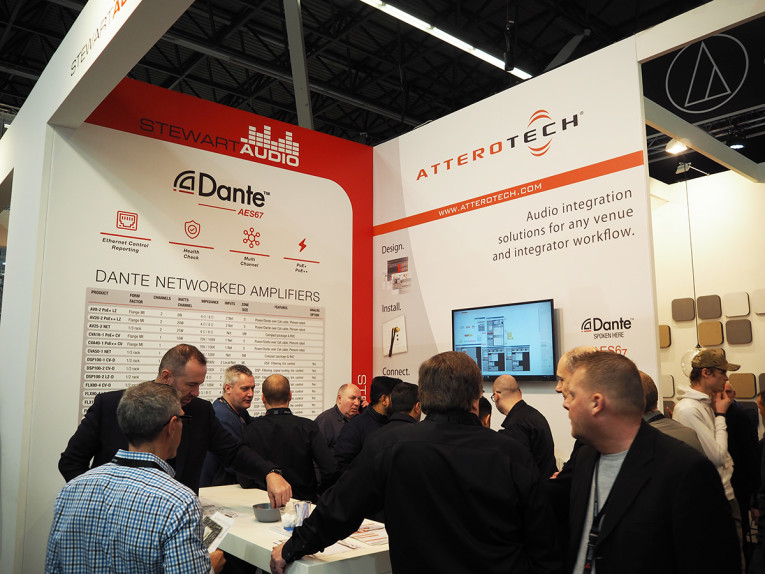
As audioXpress has been reporting for some years now, other OCA member companies, such as Archwave Technologies, Attero Tech, DeusO, Focusrite, Profusion, and Your Audio Systems, have been extremely active in promoting demonstrations and providing tools for the industry to start implementing AES70-based systems. In all the demonstrations, those and other members explained how combining AES70 system control with standard media transport allows devices from diverse manufacturers to readily interoperate. In particular, AES70 includes a complete Discovery specification, which will complement media transport standards and solutions such as AES67. However, AES70 may be implemented with any media transport mechanism, including AVB/TSN and analog cable. Of course, the technology was always promoted has a heaven for systems integrators and end-users, since "all network devices would talk the same remote control language, clients would be free to choose the best products for their own purposes, with few compatibility concerns, and systems would have long service lifetimes with rich on-going upgradeability."
But those reasons, as important as they are for end-users, are precisely why previous efforts for a control standard were not successful. We must also admit that the reason why OCA/AES70 can be successful is because now manufacturers actually need it, because networked systems are a completely different ballgame, and because such an architecture allows new things that could not be done previously. And, very important, the OCA open control and monitoring standard can be used in conjunction with any available transport protocol (Dante, AVB, AES67, Cobranet, etc.), across different media transports and manufacturers' devices. It can even work wirelessly via standard 802.11 Wi-Fi for certain applications.
The focus now is to promote this to manufacturers. Showing them what they can do in a network. Like having a networked-microphone using an equalizer or echo canceller available in a Yamaha DSP device connected somewhere, or dealing with cloud-based resources to optimize the coverage of a PA in a specific room, among many of the possibilities. But all within each manufacturers' devices' control applications and specific interfaces, with the AES70 standard basically translating that into "objects."
The efforts to demonstrate and evolve the technology are ongoing. Precisely at ISE 2019, the OCA Alliance announced a revision of the latest AES70-2018 standard with new developer tools and resources, making implementation "easier than ever before". There are extensive updates and new tools in this revision that make AES70 more powerful and open up even more appealing possibilities.

I visited the OCA Alliance booth at ISE 2019 to see the demonstrations and was pleasantly surprised with the fact that there were already new development solutions being shown and that the focus was now on supporting any manufacturers that want to implement products, solutions, and create practical applications. For that, I met two companies that were at the center of the demonstrations. First, was Profusion PLC, the well-known electronics distributor for audio semiconductors and components, which is also an OCA Alliance member.
The reason for the company's commitment to the effort, as Keith Persin, Managing Director, explained, has to do with the fact that Profusion already distributes products from companies that are OCA members, like THAT or Archwave, but also because being in direct proximity with audio design engineers, as a distributor of ICs and specialty devices, allows Profusion to get involved in development. Specifically, the company had a new development board in the demonstrations, which will soon enable the audio industry to easily implement OCA/AES70 solutions. The development solution will be available in the Resolute Audio brand, part of Profusion own portfolio of "audio building blocks." Interested parts should approach Profusion and request evaluation kits.

The other company, was DeusO, a company specializing in web-based user interface development and control protocol implementations, which we had met in previous years, precisely as part of the OCA Alliance's ISE demonstrations. This year, we were glad to see that the German company had a completely different approach, basically explaining how their C++ AES70 device libraries, C# and JavaScript AES70 controller libraries with unified user interfaces, are able to make cross vendor control a reality. As Matt Hardy, Business Development Manager at DeusO explained, the company is already able to offer a production ready JavaScript widget library and web-based framework for remote user interfaces, and AES70 protocol libraries for hardware devices and controller applications. More importantly, DeusO is open for business as a software developer and offers consulting services regarding AES70 protocol integration for hardware devices.
As DeusO explains, "Implementing AES70 can be a daunting task, especially when done from the ground up without the right tools and strategies. We can provide you with both the strategies and the tools." The key, of course, is making extremely visible what can be achieved and how easily it can be achieved. Preferably, things that have never been done and weren't possible before. That will be the next step.
This article was originally published in The Audio Voice newsletter 217, February 21.




